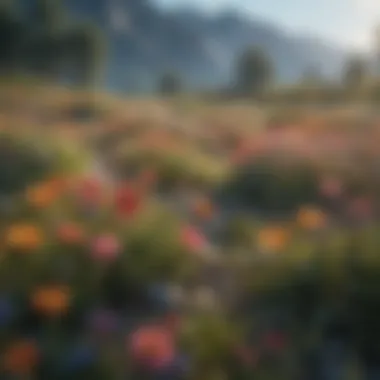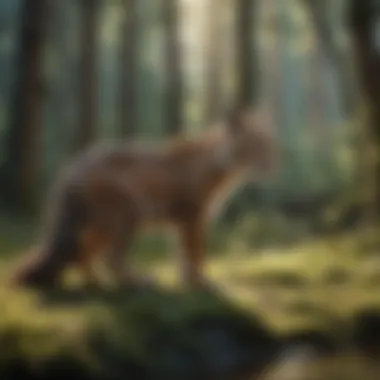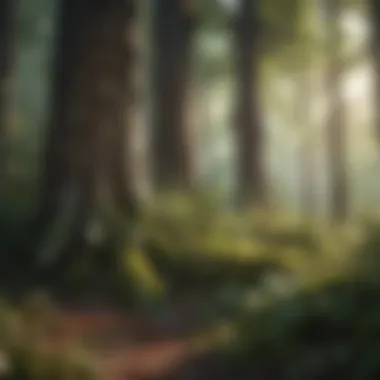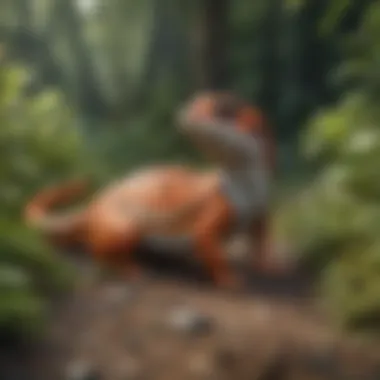Engaging Young Minds with Nature Coloring Pages


Nature Topic Overview
The world around us bursts with color, sound, and life. Nature isn’t just a backdrop for play; it’s a canvas for creativity and learning. For children aged five to twelve, exploring %nature through creative activities can stimulate their minds and enhance their understanding of their surroundings. Free nature coloring pages serve as more than just a fun activity; they can be a gateway to understanding ecosystems, wildlife, and the variety of plant life.
Imagine a child transforming a simple black-and-white outline into a vivid depiction of a forest scene or an underwater habitat. These coloring pages not only foster artistic expression but also encourage curiosity about the creatures that inhabit these environments. From colorful birds to intricate flowers, each page turned into a work of art can ignite discussions about the role of each species in our ecosystem.
Fun Facts and Trivia
To get young minds engaged, it’s often effective to present them with cool facts that spark interest. Did you know that some plants can actually eat insects? For example, the Venus flytrap snaps shut in less than a second to catch its dinner!
Here are a few more intriguing nuggets:
- Butterflies taste with their feet! Their taste buds, located on their feet, help them to identify if a plant is good for laying eggs.
- Octopuses have three hearts. Two pump blood to the gills, while the third pumps it to the rest of the body.
Consider integrating visuals like pictures or interactive quizzes to enhance the learning experience. A fun way to do this could be creating a memory game with animal images, where children match different species with their habitats.
"Exploring nature and engaging with it creatively fosters both knowledge and appreciation."
Wildlife Explorations
Wildlife is a treasure trove of learning experiences. When kids dive into coloring pages that depict various species, they can discover astonishing facts about animals. For instance, did you know that hummingbirds are the only birds that can fly backward? Each coloring session can turn into an adventure, analyzing what these creatures look like, where they live, and how they fit into their environments.
Some notable species to consider incorporating into coloring pages include:
- Red foxes: Highly adaptable, red foxes thrive in urban and rural settings, often seen as cunning and clever.
- Green sea turtles: These gentle giants spend most of their lives in water, but they return to land to nest.
Integrating quizzes about the habitats of these animals can further enhance this experience. An interactive element like identifying animal tracks can deepend children’s understanding of wildlife behavior.
Environmental Awareness
Discussing conservation is crucial, especially as children begin to form their own understandings of the world. Using nature coloring pages, parents and educators can emphasize the importance of protecting wildlife and their habitats. Children can learn about why certain species are endangered and the small efforts they can make to help.
Some practical tips for kids could include:
- Planting a garden: Even a small container garden promotes biodiversity.
- Participating in local cleanups: Instilling the values of community involvement and environmental stewardship early on teaches responsibility.
DIY Nature Activities
A hands-on approach can deepen children's engagement with nature. Here are some easy DIY activities kids can try:
- Create Nature Collages: Gather leaves, flowers, and twigs to make a vibrant collage. It’s a great way to appreciate beauty while being eco-friendly.
- Craft Bird Feeders: Use pine cones, peanut butter, and birdseed to create a feeder. Hang it outside and learn about the birds that come to visit.
- Nature Scavenger Hunts: Create a list of flowers, bugs, and birds for kids to find during a walk. They can check off items as they go and later color in their discoveries.
Each of these activities can lead to discussions about what was learned, fostering a deeper respect and understanding for nature.
Words and colors truly hold the power to transform perception. As families transform blank pages into art, they also build a foundation for a lifetime of exploration and appreciation for the natural world.
Prelims to Free Nature Coloring Pages
Free nature coloring pages serve as a delightful gateway to fostering creativity and learning in children. These resources offer not just a fun way to spend time but also a means to explore the beauty of the great outdoors. From wildlife to flora, these coloring pages invite young minds to engage with nature in a colorful manner.


Coloring, as a simple yet engaging activity, plays a pivotal role in a child’s development. It's more than just filling in a sketch with colors; it's about enhancing fine motor skills, stimulating the imagination, and helping children express themselves in a non-verbal way. Free nature coloring pages act as a bridge between artistic outlets and educational themes, making them invaluable for both parents and educators.
In this article, we delve deeper into the multifaceted benefits of these coloring pages. We aim to highlight how they can enrich children’s understanding of the natural world, bolster awareness of biodiversity, and provide platforms for relaxation and mindfulness. It's about creating a space where art and nature intertwine, leading to holistic growth.
The Role of Coloring in Child Development
Coloring is a crucial activity that can significantly influence a child's psychological and physical development. It helps improve hand-eye coordination through the action of gripping crayons and controlling motion as they color within the lines. Moreover, this seemingly simple task encourages concentration and helps strengthen memory recall.
When children work with different colors, they start to associate properties and emotions with those colors. For instance, they might see blue and feel calm or choose red for something exciting. This process fosters their emotional intelligence effectively, teaching them to recognize and express their feelings. Ultimately, the act of coloring becomes a powerful tool in shaping thoughts and emotions.
Besides the fine motor skills and cognitive benefits, coloring can also enhance creativity. Children become more inventive when given the freedom to choose colors and designs. With nature-themed coloring pages, this creative exercise transitions into an exploration of the environment, allowing young artists to learn about various plants and animals while they color.
Nature as an Educational Theme
Introducing nature as an educational theme can open up a treasure trove of learning opportunities for kids. By integrating nature into coloring pages, children aren’t just coloring; they are also learning about ecological systems, adaptation, and conservation in a vivid and interactive way.
A coloring page might feature a majestic oak tree or a colorful butterfly. These images can lead to discussions about habitats, life cycles, and the importance of biodiversity. Thus, coloring becomes a stepping stone to broader educational conversations.
Here are some aspects of nature as an educational theme:
- Encourages Curiosity: When children color images of nature, their curiosity often piqued. They may ask questions about the animals they are coloring or the types of flowers depicted on the page.
- Promotes Environmental Awareness: Coloring pages featuring endangered species or plants can instill a sense of responsibility in children, encouraging them to care for their environment from a young age.
- Fosters Connection with Nature: Engaging with nature through art can stimulate an appreciation for the world outside their door. Children might become motivated to explore gardens, parks, or forests after coloring.
Overall, combining artistic expression with themes from nature paves the way for comprehensive learning experiences that align with educational goals.
"Coloring isn’t just an activity; it’s a pathway to understanding the world around us."
Benefits of Nature Coloring Pages
Coloring might seem like just a casual activity but it packs a punch when it comes to child development. Nature coloring pages, in particular, bring a unique blend of creativity and education that enhances the learning experience for children aged five to twelve. Through these pages, kids not only engage in an artistic endeavor but also connect with the world around them, laying the groundwork for a deeper appreciation of nature and biodiversity.
Enhancing Creativity and Self-Expression
Coloring is often the first outlet for children to express themselves artistically. When kids take crayons to paper, they transform blank spaces into vibrant landscapes, or in this case, beautiful depictions of flora and fauna. This activity provides a safe space for children to unleash their imagination without pressures of judgment.
Nature coloring pages come with various themes from intricate leaf patterns to wild animals. Letting kids choose their colors and styles encourages them to explore their unique preferences. It’s astonishing to see how two children can color the same scene so differently—one might see a sunset in fiery reds and oranges, while another embraces the cool blues of twilight. This process of experimentation fosters creative thinking, which is essential in many aspects of life.
Promoting Awareness of Biodiversity
When children color images of various plants, animals, and ecosystems, they are not simply filling in shapes. They are actually learning about biodiversity in an interactive way. Nature coloring pages steer kids toward recognizing the different species around them and their roles within the ecosystem.
Informing children about the diversity of life can stimulate empathy towards other living beings. For instance, coloring a picture of a bustling forest full of animals can spark conversations about the importance of plants in our lives or the role of different animals in maintaining ecological balance.
Additionally, integrating information about the featured animals or plants on the coloring pages could enrich their learning experience, creating a bridge between coloring and direct education. This not only enhances awareness but ultimately helps children to understand and possibly advocate for environmental conservation in their communities.
Encouraging Mindfulness and Relaxation
Coloring can be a meditative practice, especially when the subject matter is grounding, like nature. Engaging with nature-inspired coloring pages helps children focus their thoughts and promotes a sense of calm. As they pick colors and fill in the designs, they often find themselves absorbed in the act, providing an escape from life’s daily stresses.
Mindfulness is increasingly recognized as a valuable trait for emotional well-being, and nature coloring pages can be a starting point. As kids relax and engage in this focused activity, they develop a form of awareness that can extend beyond their drawings and into their daily interactions. Demonstrating how to be still, appreciate the process of creation, and engage fully in an activity are skills that will serve them well as they grow.
"The connection between art and cognitive development is clear; through nature coloring, children are given the freedom to express and discover who they are while learning about the world around them."


Types of Nature Coloring Pages
Understanding the different types of nature coloring pages is essential in leveraging their educational potential for young minds. Each category offers unique opportunities for development, creativity, and awareness. From flora to fauna, and even the breathtaking scenes of nature, these coloring pages can captivate children, turning a simple artistic activity into a rich learning experience.
Flora-Themed Coloring Pages
Flora-themed coloring pages primarily focus on plants, flowers, and trees. They present a vibrant opportunity to not only stir creativity but also teach kids about the diversity of plant life. For instance, a simple page exploding with various flowers can open doors to discussions about botany, ecosystems, and the importance of plants in our environment. Kids often find wilsdflowers appealing, as each one showcases a different shape and color, encouraging them to express themselves uniquely with their color choices.
Moreover, these pages can serve as step one towards educating children about gardening and plant care. As they color in images of vegetable gardens or native plants, conversations about what plants need to thrive can easily arise. Engaging them with such details links the coloring activity with real-life applications, demonstrating the connection between their art and the natural world.
Fauna-Themed Coloring Pages
Likewise, fauna-themed coloring pages offer a window into the animal kingdom. These pages can range from majestic elephants to tiny ladybugs, educating young learners about various species. Coloring pictures of animals can spark curiosity about their habitats, behaviors, and diets. Picture this: a child lies on the floor, crayons in hand, coloring in an image of a pond full of frogs. As their mind wanders, they might start asking questions: "What do frogs eat? Where do they live? Why do they croak?"
Through this interaction, children not only enhance their fine motor skills but also cultivate their inquisitive nature. It becomes a journey, where each colored creature could lead to a story of its own. Understanding animals fosters empathy in youngsters. They begin to appreciate all living beings, encouraging respect for wildlife and the entire ecosystem.
Scenic Landscapes and Ecosystems
Lastly, scenic landscapes and ecosystems coloring pages weave together both flora and fauna into cohesive natural scenes. These pages can depict everything from lush forests and sprawling mountains to serene beaches and desert vistas. As children bring these images to life with colors, they can learn about geography, climate, and how different ecosystems function.
In these scenic depictions, educators and parents have the chance to introduce concepts like environmental conservation. A beautiful forest scene could inspire a discussion about the significance of forests in combating climate change or preserving biodiversity. Not only do kids get to color, but they are also planting seeds of environmental awareness and stewardship in their young minds.
"Coloring nature not only beautifies our creative space but also enriches our understanding of the world around us."
Thus, by exploring various types of nature coloring pages—flora, fauna, and scenic landscapes—children engage in multifaceted learning experiences. These categories serve as springboards for conversations, creativity, and a deeper appreciation for the rich tapestry that nature provides.
Finding and Accessing Free Coloring Pages
Accessing free nature coloring pages can feel like unearthing a hidden treasure. These colorful resources make it easier for parents, teachers, and kids to delve into the world of creativity intertwined with learning. In today’s digital age, knowing where to find these pages is vital. It opens the door to not just fun but also enrichment, allowing young minds to explore themes of wildlife, ecology, and environmental stewardship. The ability to engage in artistic pursuits through coloring lightens the typically stern weight of education while subtly enhancing comprehension and retention.
Online Resources and Directories
The internet is a goldmine of online resources, offering a plethora of nature coloring pages that can be easily accessed. Websites dedicated to educational content, such as Scholastic and Education.com, often have sections for downloadable coloring pages that emphasize nature themes. Additionally, platforms such as Teachers Pay Teachers provide spaces where educators share their original artworks, many available for free. These sites not only furnish sheets filled with flora and fauna but also often come with prompts and educational tips for parents and teachers.
Moreover, social media groups and forums, especially on Reddit or Facebook, can be havens for finding unique coloring sheets. Groups dedicated to parenting or teaching share links to lesser-known sources and even upload their custom designs. This community-centric approach keeps the coloring pages fresh and diverse, catering to varying levels of artistic ability and age appropriateness.
"Engaging with such resources can spark inspiration and creativity while making learning accessible and enjoyable for kids."
Community Contributions and Downloads
Community contributions are like the cherry on top when it comes to accessing nature coloring pages. Many individuals are passionate about sharing their artistic creations with others. Platforms that allow users to upload their designs foster a spirit of sharing and creativity. Websites such as DeviantArt and Pinterest frequently showcase a range of color pages created by artists, whether they be professional illustrators or enthusiastic hobbyists.
Local community centers or libraries also often host workshops or events where kids can create their own coloring pages. The resulting pages from these gatherings can then be shared online for others to download. Such community-oriented projects not only bolster artistic skills but encourage collaboration and shared learning.
Finding these pages isn't just about the final product; it's about connecting with others who share a passion for creativity and nature. The color pages can then serve as a vessel for dialogue, exploration, and further learning for young minds.
Activities with Nature Coloring Pages
Engaging children with nature coloring pages presents a delightful intersection of education and artistry. These activities are more than just mere pastimes; they serve as powerful learning tools. When children get their hands on coloring pages featuring various elements of nature, they don’t just color—they explore, imagine, and connect concepts.
Integrating Coloring into Lessons


Incorporating nature coloring pages into lessons can spark curiosity and reinforce learning in various subjects. For instance, while teaching about ecosystems, educators can provide coloring sheets that feature different animals or plants from those environments. This approach deepens understanding as kids leverage visual arts to absorb concepts.
Moreover, integrating these pages into lessons allows for multi-sensory learning experiences. When children color while listening to an educator discuss the importance of bees in pollination, they engage their visual and auditory senses simultaneously. This has been shown to enhance retention. Ultimately, this integration of art into academic topics contributes to a more rounded educational experience. Here are a few ideas to kickstart the integration process:
- Art and Science: Pair coloring pages with discussions about habitat, biodiversity, or life cycles.
- Language Arts: Create a storytelling session where kids describe their colored pages.
- Cultural Education: Explore the significance of particular flora or fauna in different cultures while coloring.
Group Activities and Collaborative Projects
Coloring can become a fantastic group activity that fosters teamwork and creativity. Such collaborative projects not only enhance social interaction but also enable children to learn from one another. Children can work on larger coloring murals that depict a specific ecosystem or a wildlife scene. This transforms a simple coloring session into a vibrant, collective artwork, showcasing different interpretations.
Further, these projects could involve specific themes relevant to discussions in class—like endangered species or seasonal changes in nature. When kids collaborate on these projects, they discuss colors, techniques, and design, which cultivates a sense of community and inclusion. Here are a few collaborative project ideas:
- Mural Making: Organize a mural day where kids color a large sheet showing a diverse ecosystem.
- Nature Gallery: Create a gallery where each child presents their colored piece and discusses its theme or subject.
- Story Map: Have children color geographical maps and plot where different plants and animals live, enriching their understanding of biodiversity.
With such activities, kids will not only broaden their artistic skills but also their awareness of their environment. Moreover, allowing them to voice their ideas during group projects can significantly boost their confidence and communication skills. This way, nature coloring pages evolve from a simple tool for relaxation to a rich platform for collaborative learning.
Creating Your Own Nature Coloring Pages
Creating your own nature coloring pages can transform a simple pastime into a rich educational journey for young minds. Not only does this practice stimulate creativity, but it also weaves in elements of art and science, providing a practical way for children to engage with the natural world. With a sea of possibilities paintbrushes in hand, kids can express their individual artistic visions while learning about various aspects of nature. The value of this creative endeavor cannot be overstated as it fosters an intrinsic connection between imagination and the environment.
Promoting Artistic Creativity
When children dabble in creating their own nature coloring pages, they get a chance to unleash their inner artist. It's not merely about filling in shapes; it's about interpreting their experiences with nature. Children can draw vibrant flowers with stems that curl and dance or depict wildlife that stirs their curiosity. This process is vital!
- Encourages experimentation: By drawing their own designs, kids are pushed to think outside the box. For instance, a child may decide to mix a tiger's stripes with the leafy patterns of a fern, creating a whimsical creature that doesn’t exist in the real world.
- Boosts confidence: Completing a personal artwork can bolster a child's self-esteem. Realizing that their notions and artistic choices have value is fundamental. They will start to appreciate their unique perspectives, leading to further explorations in creativity.
- Cognitive development: This hands-on creativity sharpens their fine motor skills as well. Holding crayons, markers, or other tools helps to build dexterity, while also stimulating cognitive growth as they think critically about what they want to include in their drawings.
Using Digital Tools for Design
In an increasingly digital world, utilizing technology to craft nature coloring pages can expand a child's creative horizons. Digital tools engage children in modern ways, providing a fresh take on traditional coloring activities. Children can use simple applications or software that allows them to design intricate patterns and images, blending art with technology.
- Accessibility: Many free apps are available that children can use with parental oversight. These give young artists the freedom to manipulate shapes, colors, and textures without the hassle of physical mess.
- Flexibility of design: Digital tools allow for easy editing. If a child is unhappy with a shade or wants to correct a shape, they can do so effortlessly. This promotes iterative thinking as they learn to adapt their designs.
- Sustainability: While many traditional coloring pages call for paper, digital creations can reduce waste. Children can save their designs and re-color them in future, encouraging a cycle of creativity that's also eco-conscious.
"Empowering young minds to create fosters a sense of ownership and imagination that resonates long after the activity is completed."
Ending
The discussions throughout this article reveal that free nature coloring pages are not just simple pastimes for kids; they are valuable educational tools that can foster a love of learning and an appreciation for the natural world. Making the connection between creativity and education is pivotal, especially in formative years when children are developing their identities and skills.
A few vital aspects to consider include:
- Enhancing Artistic Skills: Engaging in coloring activities allows children to improve their fine motor skills and hand-eye coordination. This sort of practice is beneficial for other tasks that require precision later in life, such as writing.
- Building Knowledge of Nature: By coloring images of different plants and animals, kids learn to recognize various species and understand their characteristics. Such knowledge lays groundwork for environmental stewardship, making them more aware of ecological issues as they grow.
- Fostering Emotional Health: Coloring can act as a calming activity, giving children a chance to express their feelings on paper. It is a non-verbal form of communication that can help them manage anxiety and stress. Amid the pressures of childhood, creating art provides a welcomed escape.
"Education is not the filling of a pail, but the lighting of a fire." - William Butler Yeats
Encouraging Lifelong Learning Through Nature
Encouraging lifelong learning through nature can be achieved by fostering curiosity about the environment from a young age. Nature coloring pages serve as a key starting point for this journey. When children explore natural themes in their coloring activities, they can develop a deeper understanding and respect for the world around them.
For example, while coloring a butterfly, a child might ask about its habitat or lifecycle. Such questions can lead to rich conversations, sparking a desire to learn more. Parents and educators can leverage these moments to extend the discussions beyond the page, perhaps leading to nature walks or visits to botanical gardens. In this way, artistic engagement becomes a tool for exploration and inquiry, solidifying a child's commitment to continuing their education throughout life. The beauty of nature coloring pages lies not only in the final product but in the curiosity they inspire.
The Future of Educational Coloring Resources
The landscape of educational resources is ever-evolving, and the future of nature coloring pages holds exciting possibilities. With the digitalization of learning tools, there are opportunities to create interactive and immersive coloring experiences. Think of apps that allow children to color on devices, then animate their art, bringing their imagined ecosystems to life.
Moreover, online platforms could enable sharing and collaboration among young artists, where they can showcase their work, comment on each other’s coloring pages, and even learn tips and techniques from one another. These advancements might not only make coloring more engaging but also cultivate a sense of community among users. Educational institutions and educators can embrace these new methods, integrating them into their curriculum to encourage children to express themselves artistically while experiencing all the benefits of nature themes.
As future resources develop, it’s essential that they cultivate accessibility, catering to all children regardless of their background. Providing free nature coloring pages will help make educational engagement available to all, diffusing the inspiration that comes from both art and nature into countless homes and classrooms.







